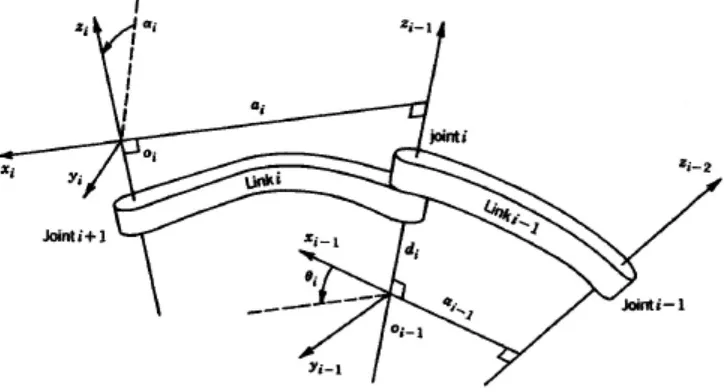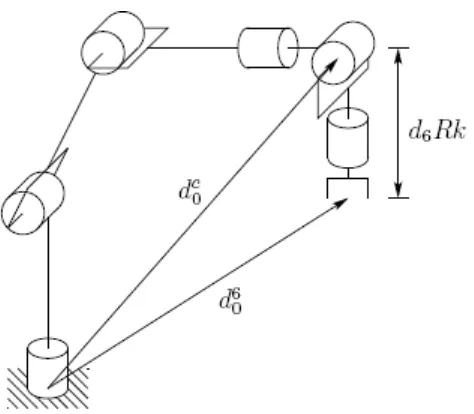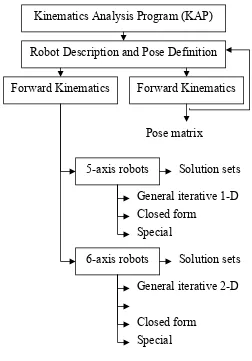INVERSE KINEMATICS SOLUTION FOR 6 DEGREE OF FREEDOM OF FANUC LR MATE 200IB ROBOT
Mohd Khafizuddin Bin Khairuddin Bachelor of Mechatronic Engineering
“I hereby declare that I have read through this report entitle “Inverse Kinematics Solution For 6 Degree of Freedom of Fanuc LR Mate 200iB Robot” and found that it has comply the partial fulfillment for awarding the degree of Bachelor of Mechatronics Engineering”
Signature : ……….
Supervisor’s Name : ……….
INVERSE KINEMATICS SOLUTION FOR 6 DEGREE OF FREEDOM OF FANUC LR MATE 200IB ROBOT
MOHD KHAFIZUDDIN BIN KHAIRUDDIN
A report submitted in partial fulfillment of the requirements for the degree of Bachelor of Mechatronics Engineering
Faculty of Electrical Engineering
UNIVERSITI TEKNIKAL MALAYSIA MELAKA
I declare that this report entitle “Inverse Kinematics Solution For 6 Degree of Freedom of Fanuc LR Mate 200iB Robot” is the result of my own research except as cited in the references. The report has not been accepted for any degree and is not concurrently submitted in candidature of any other degree.
ACKNOWLEDGEMENT
Alhamdulillah, finally the Final Year Project 2 (FYP 2) is complete. There are several people I would like to acknowledge for their assistance and support over the FYP 2 which is compulsory to all UTeM students to pass before awarded the degree.
First of all, I would like to sincerely thank to my project supervisor, Pn Irma Wani bt Jamaludin for undivided support morally and physically, assistance, guidance, tolerance, which proved to be invaluable as to the completion of my FYP 2. I would like to also express my gratitude to the panels, Muhammad Herman bin Jamaluddin and Mohd Razali bin Mohamad Sapiee, who give me a good comment during my presentation.
ABSTRACT
ABSTRAK
TABLE OF CONTENT
LIST OF ABBREVIATIONS viii
1 INTRODUCTION 1
2.1.1 Denavit Hartenberg Representation 6
2.2 Inverse Kinematics 8
2.3 Kinematics Analysis Program (KAP) 10
2.4 Fanuc LR Mate 200iB 12
3 PROJECT METHODOLOGY 14
3.1 Overview 14
3.3 Programming software 16 3.4 Design Software for Forward Kinematics 17
3.4.1 Manual Calculation for Forward Kinematics 17 3.4.2 Design the Software by Using Matlab 20 3.5 Design and Develop GUI for Inverse Kinematics 22
3.5.1 Set the Data of Link 22
3.5.2 Set the Initial Value of Theta 23 3.5.3 Set the Initial Final Position 23
3.5.4 Use fkine 24
3.5.5 Use ikine 24
3.5.6 Set the Range of Theta 25
LIST OF TABLES
TABLE TITLE PAGE
2.1 Robot DH-parameter table 12
3.1 DH parameter for Fanuc LR Mate 200iB 17
4.1 Data Analysis 29
LIST OF FIGURES
FIGURE TITLE PAGE
1.1 Fanuc LR Mate 200iB 1
2.1 Link Parameter 6
2.2 Kinematic Decoupling 9
2.3 Functional Block Diagram of KAP 11
2.4 Fanuc LR Mate 200iB workspace 13
3.1 Flow of the Project Methodology 15
4.1 GUI of ivFanuc gripper 27
4.2 Plot Robot 28
4.3 Home Position 30
4.4 Data 1 31
LIST OF ABBREVIATIONS
LIST OF APPENDICES
NO. TITLE PAGE
Appendix 1 Project Planning 39
Appendix 2 Fanuc LR Mate 200iB robot specification 41 Appendix 3 Command for Forward Kinematics Software 43
Appendix 4 Command for ivFanuc 46
1
CHAPTER 1
INTRODUCTION
The “Inverse Kinematics Solution for 6 Degree of Freedom of Fanuc LR Mate 200iB Robot” project is to identify and develop software and design graphical user interface (GUI) to determine the angle of each joints after the final position of the Fanuc robot is inserted by user. Figure 1.1 shows the Fanuc LR Mate 200iB robot. The GUI will be used and help the user to calculate the inverse kinematics problem for 6 DOF of Fanuc LR Mate 200iB robot. This chapter will discuss about the background of the project, the problem statement, objective and scope of the project.
2
1.1 Background of the project
Today robots are used in every walk of human life. All over the world, robots are on the move. As the robots grow tougher, nimbler, and smarter, today’s robots are doing more and more things human cannot or do not want to do. In order to co-operate with a human, a robot should have a humanlike behavior when moving. Then, the robot can act in a world made for humans and does not perform movements which cannot be anticipated by the human partner. To achieve this, it is necessary to give the robot human like configuration and human like kinematics.
Robotics is a multidisciplinary, highly mathematical topic usually taught at the graduate level. A typical course will start with a review or introduction of mathematical concepts, then on to kinematics of robot manipulators, followed by elements of dynamics and control that still rely heavily on the kinematics portion of the course. [1]
Kinematics is one of the most important aspects of robots movement and it is essential to understand the concept to analyze the complex movements of a robot and the operations it can perform. The human like shape and configuration of the robot enables the robot to co-operate with the human partner the same way humans co-operate with each other. Therefore, the robots arm moves like a human arm and interacts with a human by physical means.
In order to solve the kinematics problem, a conventional method which has a lot of complexity equation and calculation must be applied. However, it is hard to be implemented in practice even many industrial robots are built with simple geometries to simplify the associated kinematics computations such as Fanuc LR Mate 200iB robot.
3
1.2 Problem statement
Many industrial robots are built with simple geometries such as intersecting or parallel joint axes to simplify the associated kinematics computations. The mathematical complexity of solving robots of general architecture detracts instructors and students from using robots with arbitrary structures in illustrative examples and assignments. This is also one of the major problems for the 6 DOF of an industrial robot which is to solve the inverse kinematics.
The inverse kinematics problem is much more interesting and its solution is more useful. It does the reverse of forward kinematics. Given the end point of the structure, what angles do the joints need to achieve that end point? At the position level, the problem is stated as, "Given the desired position of the robot's hand, what must be the angles at all of the robots joints?" Humans solve this problem all the time without even thinking about it. When you are eating your cereal in the morning you just reach out and grab your spoon. You don't think, "My shoulder needs to do this, my elbow needs to do that, etc." So, we will look how most robots have to solve the problem. [2]
Solving the inverse kinematics problem need a lot of calculation when using conventional method. The complexity of formulation and computational burden make this method hard to be implemented in practice which also will waste a lot of time. Therefore, a new method of solution must be developed to solve the inverse kinematics equation such as using software programming.
4
1.3 Objective
The objectives of this project are to solve an inverse kinematics for 6 DOF of Fanuc LR Mate 200iB robot. In order to solve the problem, the algorithm will be develop and then the programming software will be identify and develop which is to design the graphical user interface. Specifics objectives of this project are:
1. To calculate inverse kinematics solution.
2. To develop an algorithm of inverse kinematics solution.
3. To design a graphical user interface (GUI) for inverse kinematics for 6 DOF of Fanuc LR Mate 200ib robot.
1.4 Scope
In general, this project is to identify and develop the programming software for solving the inverse kinematics problem which focuses only for 6 DOF of Fanuc LR Mate 200iB robot. Thus, it cannot be apply to other type of robot unless both program and interface is modified.
To solve the inverse kinematics problem for 6 DOF of Fanuc LR Mate 200iB robot, the programming software will be identify whether it is suitable for solve the inverse kinematics. Then, an algorithm will be developed. At the end the GUI will be developed to solve the inverse kinematics problem.
5
CHAPTER 2
LITERATURE REVIEW
In this chapter, a review of previous research project that are related of this project will be discussed. The information about forward and inverse kinematics and Fanuc LR Mate 200iB robot are also described in this chapter.
2.1 Forward Kinematics
The forward kinematics problem is concerned with the relationship between the individual joints of the robot manipulator and the position and orientation of the tool or end-effector. Stated more formally, the forward kinematics problem is to determine the position and orientation of the end-effector, given the values for the joint variables of the robot. The joint variables are the angles between the links in the case of revolute or rotational joints, and the link extension in the case of prismatic or sliding joints.
6
In the usual case of revolute joint, i is called the joint variable, and the other three quantities would be fixed link parameters. For prismatic joints, di is the joint variable and the other three quantities are fixed link parameters. The definition of mechanism by means of these quantities is a convention usually called Denavit-Hartenberg (DH) notation [3].
2.1.1 Denavit Hartenberg Representation
Figure 2.1: Link Parameter.
7
O in any convenient position alongzi.
Step 4: Establish xi along the common normal between zi1 and zi through Oii, or in the direction normal to the zi1zi plane if zi1 and zi intersect.
Step 5 : Establish yi to complete a right-hand frame.
Step 6 : Establish the end-effector frameo x y zn n n n. Assuming the n-th joint is revolute is variable if joint i is prismatic.
i
The angle between zi1 and zi measured about xi(see Figure 2.1).
i
The angle between xi1 and xi measured about zi1 (see Figure 2.1). i is variable if joint i is revolute.
Step 8 : Form the homogeneous transformation matrices Ai by substituting the above parameters into equation 2.1.
Step 9 : Form 0
1....
n n
8
The overall transformation is obtained by post multiplication of individual transformations:
9 In the general problem of inverse kinematics is quite difficult, it turns out that for manipulators having six joints, with the last three joints intersecting at a point. It is possible to decouple the inverse kinematics problem into two simpler problems, known respectively, as inverse position kinematics, and inverse orientation kinematics. To put it another way, for a 6 DOF manipulator with a spherical wrist, the inverse kinematics problem may be separated into two simpler problems, namely first finding the position of the intersection of the wrist axes, hereafter called the wrist center, and then finding the orientation of the wrist.
10 For this class of manipulators the determination of the inverse kinematics can be summarized by the following algorithm.
Step 1: Find q1, q2, q3 such that the wrist center oc has coordinates given by
0
Step 2: Using the joint variables determined in Step 1, evaluateR30. Step 3: Find a set of Euler angles corresponding to the rotation matrix
3
0 1
06 3 3
T
R R R R R
2.3 Kinematics Analysis Program (KAP)
Kinematics Analysis Program is a program written by Rachid Manseur [1]. KAP is currently written to compute the forward and inverse kinematics of robot manipulators with 5 or 6 revolute degrees of freedom. The functional block diagram of KAP is shown on Figure 2.3. There are two types of KAP:
i. KAP5 – to compute the inverse kinematics problem for 5 DOF of Rhino XR-3 robot.
11
Figure 2.3: Functional Block Diagram of KAP
In this program, the user is asked to enter the Denavit-Hartenberg (DH) parameter table for the robot. The DH-parameters can be entered from the keyboard or by specifying a pre-existing file name containing the robot DH parameters in the format shown on Table 2.1. The end effectors pose can also be entered through the keyboard, read from a pre-existing file named POSE.DAT, or computed from joint angles that the user enters through the forward kinematics block. The program determines the number of DOF of the robot and applies the proper algorithm [1]. Even this program is to compute the inverse kinematics of Fanuc LR Mate 200iB robot, it still can be use as a sample for design a GUI for this project.


